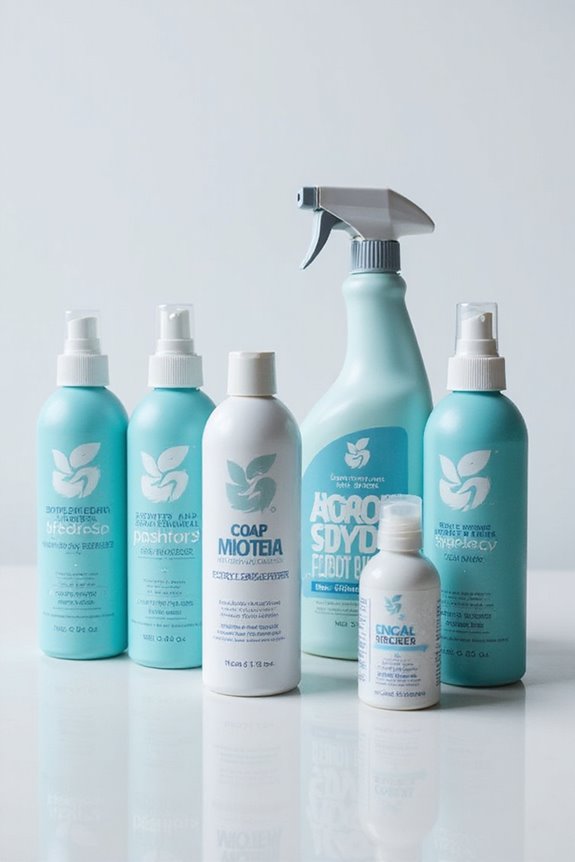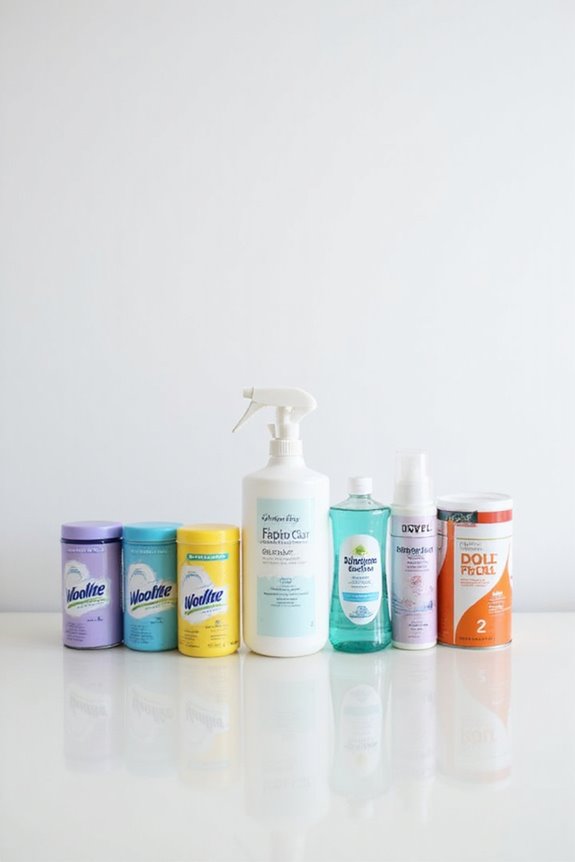Are fabric refreshers safe for allergies? Well, it’s a bit of a toss-up. They can really help freshen up our clothes and furniture, but many contain fragrance chemicals that could irritate sensitive skin or trigger allergies. We’ve noticed that hypoallergenic options are usually safer. It’s smart to test them on a small patch first. If you’re cautious about ingredients, you’ll want to stick around—there’s more to explore on how to keep your space allergen-free!
Key Takeaways
- Fabric refreshers can cause skin irritation and respiratory issues, especially for those with sensitivities to fragrance chemicals.
- Up to 32.2% of individuals report sensitivity to fragranced products, necessitating caution for allergy-prone users.
- Hypoallergenic and fragrance-free options are recommended for individuals with allergies to minimize irritation risks.
- Testing a small area of fabric before widespread use can help identify potential allergic reactions.
- Regular laundering is the most effective method for removing allergens, rather than relying solely on fabric refreshers.
Understanding Fabric Refreshers and Their Purpose
When we think about keeping our fabrics fresh, fabric refreshers often come to mind as the superheroes of odor elimination. These specialized products are designed to tackle unpleasant smells trapped in our clothing, curtains, and upholstery. The benefits of fabric refreshers are clear—they neutralize odors and deliver a pleasant fragrance, extending the life of our fabrics between washes.
Using them is simple! We just spray, let them dry, and voilà—fresh-smelling textiles! There are various application techniques, like targeting specific areas or doing a light overall mist. We’ve all had that moment when our favorite sweater needs a little pick-me-up, and that’s where fabric refreshers come in handy. They’re our go-to for quick freshness! Additionally, many fabric refreshers, such as Tide Antibacterial Fabric Spray, also help eliminate bacteria, ensuring a deeper clean.
Potential Allergy Risks Associated With Fabric Refreshers
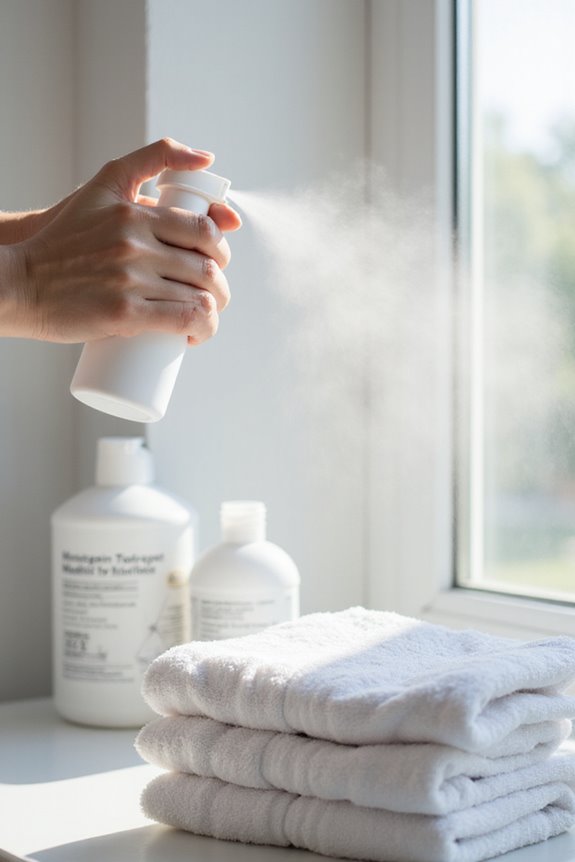
Although we love the fresh scent that fabric refreshers bring to our homes, we can’t ignore the potential allergy risks that come with them. Many of these products contain fragrance chemicals like linalool and limonene, which can be sneaky allergens. They might cause skin irritation or even respiratory issues. We should be cautious, especially in poorly ventilated spaces, as aerosolized particles can exacerbate our breathing problems. Plus, the ingredients are often not fully disclosed, making allergen identification a challenge. When we use these refreshers frequently, it increases our exposure risks. So, while a fresh-smelling room is nice, we need to weigh the benefits against the potential for allergic reactions. Let’s stay aware and make informed choices!
The Impact of Fragrance Chemicals on Allergic Individuals
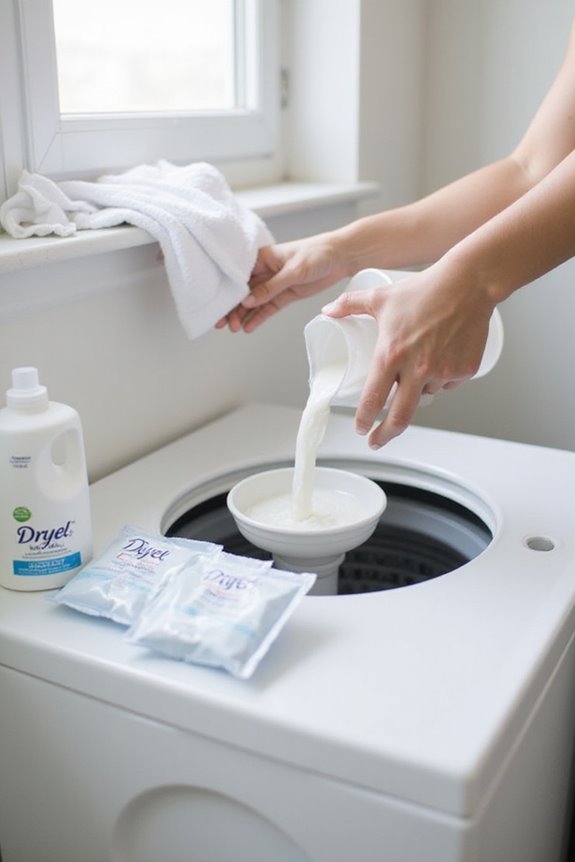
Fragrance chemicals found in fabric refreshers can really pack a punch, especially for those of us with allergies. These chemicals, like isoeugenol and cinnamal, can trigger allergic reactions even in tiny amounts. It’s a bit alarming to think that up to 32.2% of people report sensitivity to fragranced products. For us, this might mean sneezing fits or itchy skin when we use fabric refreshers. Plus, the problem is compounded since many of these products use hydroalcoholic bases, which can make allergens penetrate our skin more easily. So, if we’re among the 1.9% who have a fragrance contact allergy, we need to be extra cautious. Let’s keep our noses and skin happy by reading labels carefully!
Air Fresheners vs. Fabric Refreshers: A Comparative Analysis
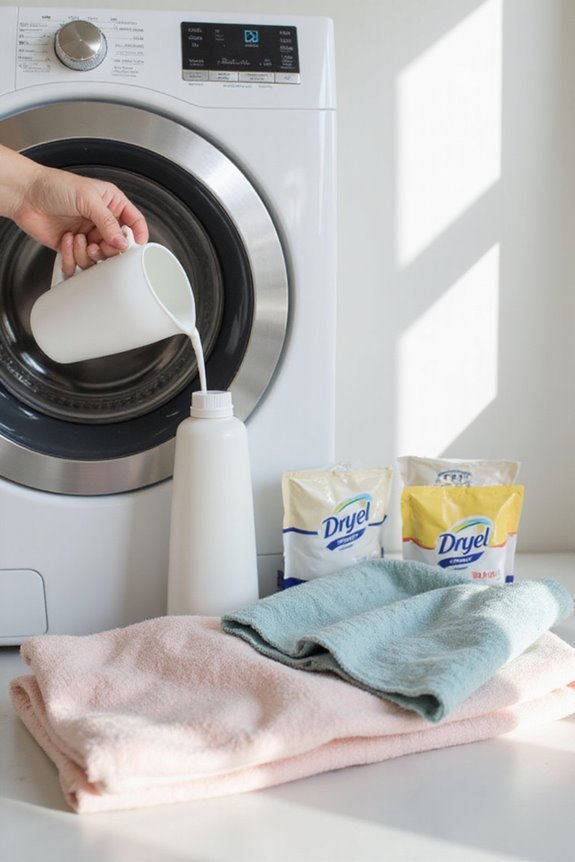
While we might think air fresheners and fabric refreshers serve the same purpose, they’re actually quite different. Air fresheners are all about keeping the air smelling fresh in larger spaces, while fabric refreshers focus on eliminating odors from textiles. In our air fresheners comparison, we find that air fresheners often use advanced tech for long-lasting scent, making them great for rooms. On the flip side, fabric refreshers effectiveness shines when targeting specific odors like smoke on curtains. They’re sprayed directly on fabrics for immediate results, but we need to reapply them for lasting freshness. So, when choosing between the two, consider what you’re tackling—air or fabric odor! It’s all about what fits your needs best.
Key Ingredients to Watch Out for in Fabric Refreshers

When it comes to fabric refreshers, it’s crucial to know what’s in the bottle. Some ingredients can be tricky for those with allergies. For instance, fragrance components like alpha-isomethyl ionone and eugenol are common culprits. They might smell nice, but they can trigger sensitivities.
We also need to pay attention to pH balance. Ingredients like citric acid help maintain this balance, ensuring the product is safe for our fabrics. Yet, if they’re in high concentrations, they might irritate our skin.
On our journey to fresh-smelling fabrics, let’s keep an eye out for these potential irritants. After all, who wants a sneeze fest when we’re just trying to enjoy a clean home?
Evidence on Fabric Refreshers and Respiratory Allergies
As we explore fabric refreshers, it’s important to recognize their potential impact on our respiratory health. Many of us may not realize that the fragrances in these products are major allergy triggers. Studies show that about 20% of the general population experiences health issues from scented products, and for asthma sufferers, that number jumps to 34%. The volatile organic compounds, or VOCs, in fabric refreshers can worsen symptoms like wheezing and nasal congestion. Even low concentrations can disturb sensitive individuals, leading to sneezing or itchy noses. We all want our homes to smell fresh, but we should be mindful of what we’re spraying in the air. After all, fresh air might be the best refresher of all!
Recommendations for Allergy-Sensitive Users
Finding the right fabric refresher can feel overwhelming, especially for those of us with allergies. To minimize reactions, we should stick to hypoallergenic products that exclude common irritants. It’s also wise to choose fragrance-free options since scents can trigger our sensitivities. When we use these products, light application techniques are key. A gentle spray and allowing fabrics to air dry can help reduce inhalation of irritants. Additionally, opting for products labeled as hypoallergenic and dermatologist-tested can further ensure safety for sensitive individuals.
User experiences highlight the importance of testing on a small fabric patch first. Ventilating the room while using a refresher can also lessen airborne allergens. Remember, regular laundering is our best friend for allergen removal, and fabric refreshers are just the cherry on top! Let’s stay allergy-safe together!
The Importance of Ingredient Transparency
Ingredient transparency is essential for anyone trying to navigate the world of fabric refreshers, especially if we have allergies. When we look at ingredient labeling, we often encounter the term “fragrance.” This catch-all can hide a multitude of chemicals, some of which might cause reactions. So, fragrance disclosure matters!
Many brands don’t disclose all their ingredients, making it tricky for us to know what we’re using. States like California enforce stricter rules, but not all fabric refreshers are created equal. Some brands go the extra mile to list everything, which we appreciate. Knowing the full picture helps us make better choices, avoid irritants, and breathe easier in our homes. After all, we want our refreshers to do more than just smell good! Additionally, choosing products that focus on eco-friendly formulations can further minimize allergic reactions and environmental impact.
Alternatives to Chemical Fabric Refreshers
When it comes to keeping our fabrics fresh, we’ve got some fantastic alternatives to those chemical-laden fabric refreshers. One great option is creating our own DIY sprays using natural ingredients. We can mix water and rubbing alcohol or vodka with essential oil blends like lavender or lemon for a lovely scent. Adding baking soda helps absorb stubborn odors, while witch hazel is a gentle alternative to alcohol. Plus, these natural deodorizing techniques mean fewer irritants, making them safer for allergy sufferers. We can customize our sprays to suit our preferences and even refill reusable bottles, reducing waste. Additionally, opting for fragrance-free products can provide effective cleaning without the risk of allergic reactions. So, why not give these homemade fabric refreshers a try? Our noses—and the planet—will thank us!
Making Informed Choices for Allergy Management
As we navigate the world of fabric refreshers, it’s essential to make informed choices, especially for those of us who deal with allergies. We need to evaluate our scent sensitivity and potential allergen exposure. Some fabric refreshers may contain undisclosed fragrance chemicals, which can trigger allergy symptoms. It’s smart to check labels for common allergens like isoeugenol. We should also be cautious with products containing phthalates, as these can disrupt hormones and worsen asthma. Testing products in small areas first can help us gauge reactions. Let’s remember, just because something smells good doesn’t mean it’s good for us. Staying aware of what we’re spraying around our homes can make a big difference in our allergy management journey. Additionally, choosing hypoallergenic fabric sprays can help minimize allergic reactions and improve overall comfort in your living space.
Frequently Asked Questions
Can Fabric Refreshers Cause Long-Term Health Effects?
We’ve seen evidence suggesting fabric refreshers can lead to long-term health effects from chemical exposure. Many users report respiratory irritation, highlighting the potential risks associated with prolonged use of these products in our homes.
Are There Specific Brands Safer for Allergy Sufferers?
Maneuvering through the fabric refresher forest, we find some brands shine brighter due to ingredient transparency. In our quest, we should seek those that openly share their contents, ensuring safer choices for our allergy-sensitive companions.
How Often Should Fabric Refreshers Be Used Safely?
When considering usage guidelines, we should follow frequency recommendations that suggest limiting fabric refresher applications to once daily or less. Regular fabric washing can also help minimize our reliance on these products for freshening.
Do Fabric Refreshers Expire or Lose Effectiveness Over Time?
Yes, fabric refreshers do expire and lose effectiveness over time. We should look for expiration indicators on the packaging, as their effectiveness duration typically ranges from one to three years, depending on storage conditions.
Can Pets Be Affected by Fabric Refresher Use?
When our friend’s cat sneezed uncontrollably after they used a fabric refresher, we realized pet sensitivities are real. Luckily, there are safe alternatives we can explore to keep our homes fresh without risking their health.



